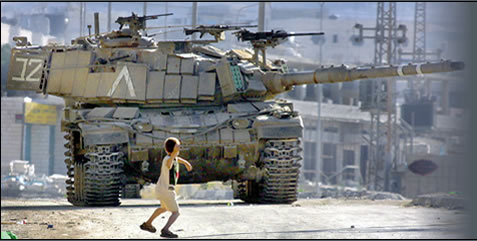Intifada
INTIFADA IS THE name given to the popular uprising of the Palestinian population against the continuation of Israeli occupation of the West Bank and Gaza Strip. There have been two Intifadas, the first, essentially spontaneous and indigenous, began in December 1987 and continued sporadically until the early 1990s. The second Intifada began after the collapse of the Camp David peace talks in September 2000. The Intifada was then under the control of various political parties and the Palestinian Authority and was a conscious military tactic, using the name of a popular precursor.
Many political commentators have attributed the holding of the Madrid peace talks in 2001 and the signing of the Oslo Accords in 1993 as resulting, in part, from the events of the first Intifada and the realization that a democratic Israel, even with the strongest military force in the region, could not continue to control a civilian population of 3 million people against their wishes and their demand for sovereignty and independence.

The first Intifada broke out at the end of 1987 initially in the Gaza Strip. It soon spread to all of the occupied territories. It was the first time in 20 years of Israeli occupation that a geographically coordinated mass civilian uprising against Israeli occupation and the occupation military authorities had taken place. It was characterized by widespread acts of civil disobedience and the use of nonlethal weapons. The throwing of stones and the burning of tires and blocking of roads, followed by Israeli military retaliations and the imposition of curfews on Palestinian villages, became an almost common occurrence during this period. The actions united and coordinated once separate and distinct villages and people. It was an organization primarily of youth and not controlled by the Palestine Liberation Organization or Yassir Arafat. For the first time, it became unsafe for Israelis to travel throughout the West Bank. Former places of Israeli-Palestinian interaction, such as the weekend markets in the Palestinian town of Kalkliyah and the commercial nodes of East Jerusalem, ceased to function as a result of the fear on the part of Israelis.
The second Intifada broke out following the breakdown of the Camp David Peace Talks in 2000. Each side blamed the other for the failure to reach a final peace agreement. The frustration among the Palestinian population, who had expected, finally, to achieve their independence, became evident through renewed acts of violence against Israel and the Israeli military authorities. Unlike the first Intifada, the second Intifada was not spontaneous. It also was characterized by a shift to the use of lethal weapons, many of which had been accumulated during the 1990s.
As a result of the Oslo Accords, the Palestinians had achieved limited autonomy in parts of the West Bank and Gaza Strip. The influence and direct intervention of the more radical political organization, the Hamas (which was in its infancy during the period of the first Intifada) also resulted in the introduction of suicide bombers in Israeli civilian centers causing significant carnage and death inside Israel itself. The conflict was now carried outside the occupied territories and into once safe districts of Israel itself.
The demand by Israelis for greater security resulted in the election of a hard-line right-wing government under the leadership of Prime Minister Ariel Sharon, who in turn proceeded to use the full might of the Israeli army to retaliate against the Palestinian population, in some cases almost totally destroying the civilian infrastructure that had been established during the post-Oslo period.
The Israeli government argued that it was the responsibility of the Palestinian Authority, under he leadership of Chairman Arafat, to reign in the violence, despite the fact that he had gradually lost control of the more radical elements within the Palestinian population, and especially throughout the Gaza Strip which had become the headquarters of the Hamas movement.
The Israeli government also targeted leading Hamas leaders, most notably Sheikh Ahmed Yassin, for assassination (in 2004) while claiming that they could no longer do business with Arafat and that, in the absence of an alternative Palestinian leader, there was no “partner” for political negotiations. This position was backed up by the George W. Bush administration, bringing about the almost total isolation of Arafat and the suspension of any peace talks between the two sides. With Arafat's death in 2004, newly elected Palestinian leaders brought a fresh approach to negotiations.